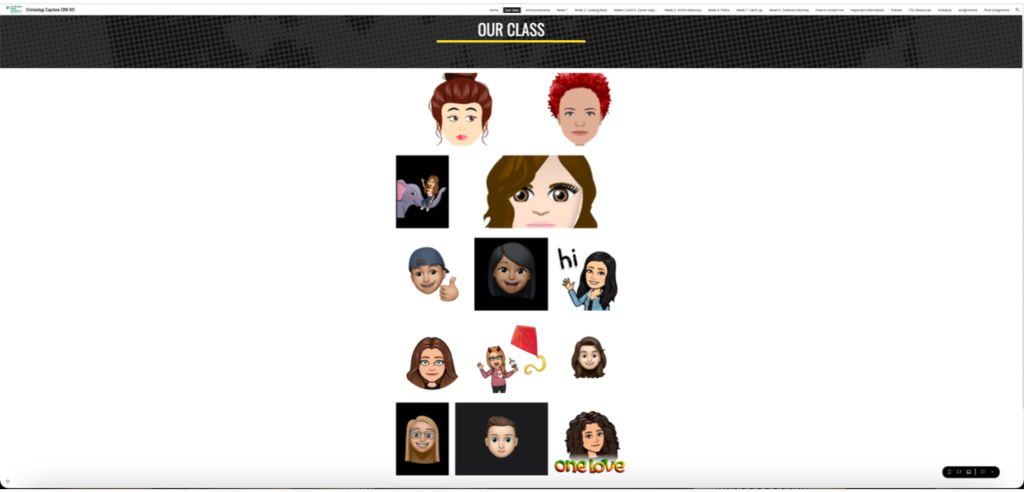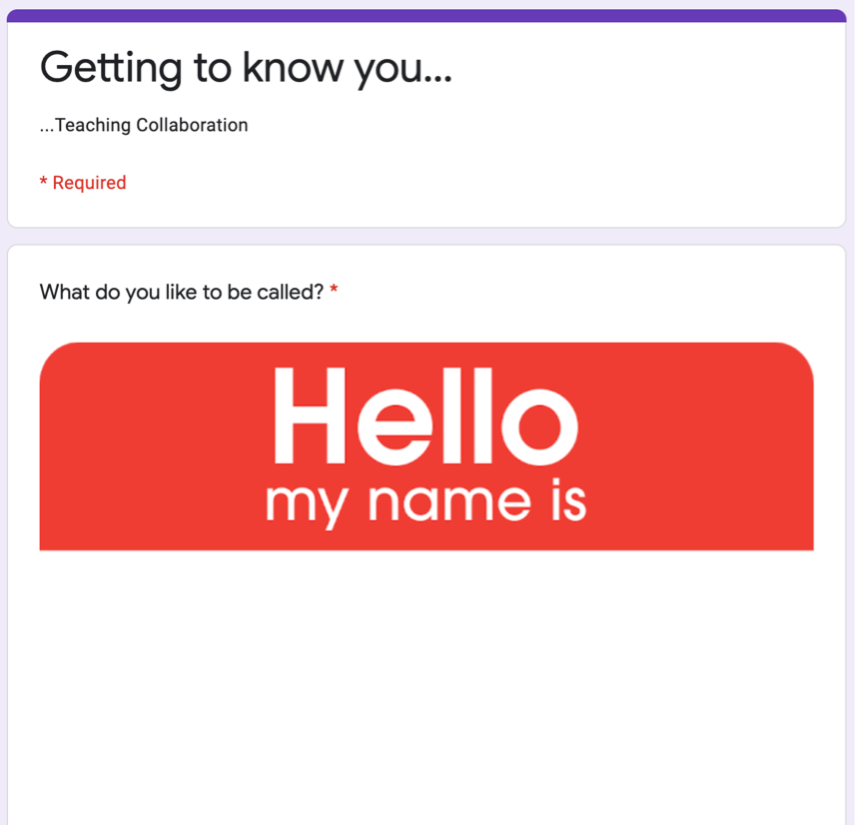Course(s): CRM 349, CRM 401
Department: Department of Criminology, Anthropology, and Sociology
Institution: Cleveland State University
Instructor(s): Dr. Dana J. Hubbard
Number & Level of Students Enrolled: 35-55
Digital Tools/Technologies Used: Google Site
Author Bio (50-100 words): Dana Hubbard is an associate professor in the Department of Criminology, Anthropology, and Sociology at Cleveland State University. Her research areas are women, race, and criminal justice. She currently teaches, Race, Class and Crime, Women and Crime and the Criminology Capstone course.
The pandemic of 2020, while having tragic consequences for many, has allowed me to develop more effective teaching techniques in my online classes. While I have been teaching online for many years, I knew that I could benefit from learning about new strategies to implement in my online courses. When in March 2020, all classes went virtual with no warning, I decided that this was the time “to get to work” improving my classes.
During the spring and summer of 2020, I read about teaching pedagogies, followed educators on Twitter, joined a higher-ed teaching group, talked to friends who teach in primary schools, and took Flipping Your Remote Classroom and Small Teaching Online through Cleveland State. I also read many books and articles on engaging students in online courses. I was eager to put into practice concepts like Backward Designs, Flipped Learning, Social Presence, and using formative assessments. It was the general teaching philosophy called “Humanizing Learning” (see Michelle Pacansky-Brock’s work- link below) that I was most struck by. My teaching philosophy has always focused on prioritizing the personal, communal approach and the importance of being approachable, supportive, caring, and enthusiastic. What I lacked, however, was more information on how to formally implement activities/tasks that utilize the Humanizing Teaching approach.
Humanized Teaching is a broad category and encompasses many definitions, theories, strategies, and activities. Generally, the theory suggests that educators should prioritize students’ needs above all else, utilize current events and culturally relevant ideas, and use interactive tools in which the educator and students can connect on an individual level, see more on this here. Thus, according to Pancasky and colleagues, humanized teaching is based on several other pedagogical theories; Validation Theory, Culturally Responsive Theory, and Social Presence Theory. CRT. The Validation theory assumes that many students come to college with self-doubt and lack confidence in themselves. Creating discussions, group projects, and check-ins with students helps to improve their confidence. Another theory that influences humanized teaching, according to Pancasky, is the Culturally Responsive Theory or CRT. Often higher education is based on an individualized idea of learning. That is, students are expected to navigate online courses and learn by themselves. The CRT theory suggests a more communal approach where students are supported and are “in it together.” In addition, classes should attempt to be more relevant by using current events and view the material through various lenses (such as culture, race, etc. Finally, the Social Presence theory refers to the idea that teachers should be “available for students” and interact with the students in personalized ways.
Liquid Teaching
The Humanized Teaching philosophy is not just a pedagogical theory in and of itself, but it also provides activities and suggestions on ways educators can use this theory in their courses. One of the strategies associated with humanizing the course is to give students easier-to-digest information. Many of my students do not have access to a computer and/or printer, especially during the pandemic. Numerous students utilize their phones to view course materials. The traditional syllabus (e.g., word document that includes information about the course that is usually copied and handed out to students in class) is becoming less relevant for our students. One of the innovations to the traditional syllabus and has recently been discussed is the “liquid syllabus.” A “liquid syllabus” helps overcome the obstacles of the traditional syllabus. It allows for a clear and eye-catching view of what the class will look like and how the class will be conducted. The liquid syllabus includes all of the necessary information on the traditional syllabus, but it is digital. In addition, it is more interactive and easier to digest. I chose to implement a liquid syllabus but also go a step further and call it a “liquid course.” In my liquid course, I am able to implement many types of pedagogical approaches, especially the Humanized teaching theory.
Liquid Course

I chose to use Google Sites as the platform to build my liquid course. I created a Google Site for each of my classes. On the first page of my Google Site, I uploaded basic information about the class, goals/objectives of the course, and an introductory video. In the introductory video, I told the class about myself and welcomed them to this online journey. I explained to them that I was here to support and help them meet the goals and objectives of the course. I also explained the Google Sites and how the class would work. I added general pages of information typically included in the traditional syllabus. These pages or tabs were titled, Goals and Objectives, Assignments and Grading, Schedule, Resources, Policies and Procedures, Useful Links. I also included a page on my site called, My Class. This page featured bitmojis of the students that they made and emailed to me. Once the students emailed, I copy and pasted their bitmojis into the google site. The students thus got active in the class immediately and enjoyed having their faces included in my liquid site.

The Importance of Language
An important aspect of my liquid syllabus/course was the use of more supporting language. Instead of the language on many traditional syllabi such as “don’t be late to class” and “the only excuse for missing an exam is an emergency,” I made sure that the information on the pages was written in a positive way. I used language such as, “the deadlines for assignments are guides. Please let me know if you are having difficulties making the deadlines.” I stressed to the students that we will get through this together and not to worry about strict deadlines, but to just try to get it done.
Humanizing Teaching Strategies
The liquid course (more than just a digital syllabus) allowed me to implement many of the Humanized Teaching strategies. Every week, I added a page to the google site detailing the next week’s activities, goals/objectives, tasks. I included everything (links to material etc.) they needed to complete for the week right on that page. Thus, they didn’t have to hunt assignments down. Everything was there. I used various types of teaching techniques such as videos, ted talks, podcasts, articles, and recorded lectures.
In addition to the activities the students were asked to complete by themselves, on their own time, I assigned many activities that allowed for student interactions with each other and myself. First, I included Google Sheets in my liquid course pages. This type of document allowed me to find out about their lives, their thoughts about the materials, and figure out whether they understood and learned the material. I made sure to include questions such as, “How are you doing?” “What barriers are you facing?” and “How can I help you succeed?” Second, one of their graded assignments was to engage in meaningful discussions with their peers. This too allowed me to test their knowledge about the material but also about their thoughts and feelings. Often their answers to the discussion questions and the google surveys prompted me to send personal emails checking in with them. I often emailed them when they were not active in the class and/or when they didn’t turn an assignment in. Finally, in my synchronous Zoom lecture and my office hours (I used the title “hangout hours”), I allowed time for face-to-face discussions.

A Pedagogy of Care
In the feedback that I received from the students, they relayed that they benefitted and enjoyed the opportunities for interaction with me and other students. Many reflected that they felt as if I cared and wanted them to succeed. The students said they liked the “hang out” hours and the synchronous Zoom classes. They also remarked about the ease they felt knowing that the deadlines for assignments were just guides. I stressed that my goal is for them to learn the material and complete the assignments and not worry about strict deadlines. I gave them the benefit of the doubt and was supportive of them.
Now more than ever, students and faculty are facing many challenges that they have not faced in the past. Students are struggling with mental health issues, family members getting sick and even dying from Covid, and being isolated from others. They are insecure and full of self-doubt regarding their abilities to learn online. By using the techniques/activities and strategies recommended through Humanized teaching, students will be better able to learn and navigate these challenges.
